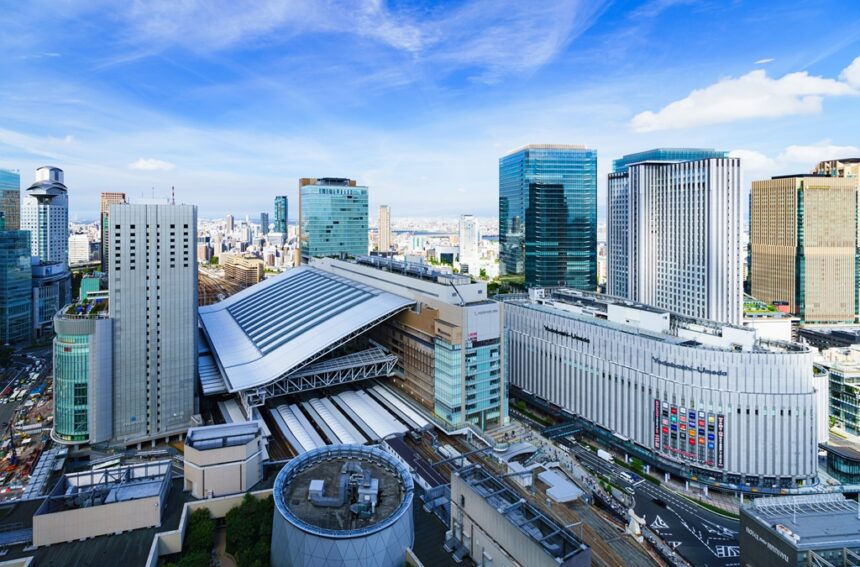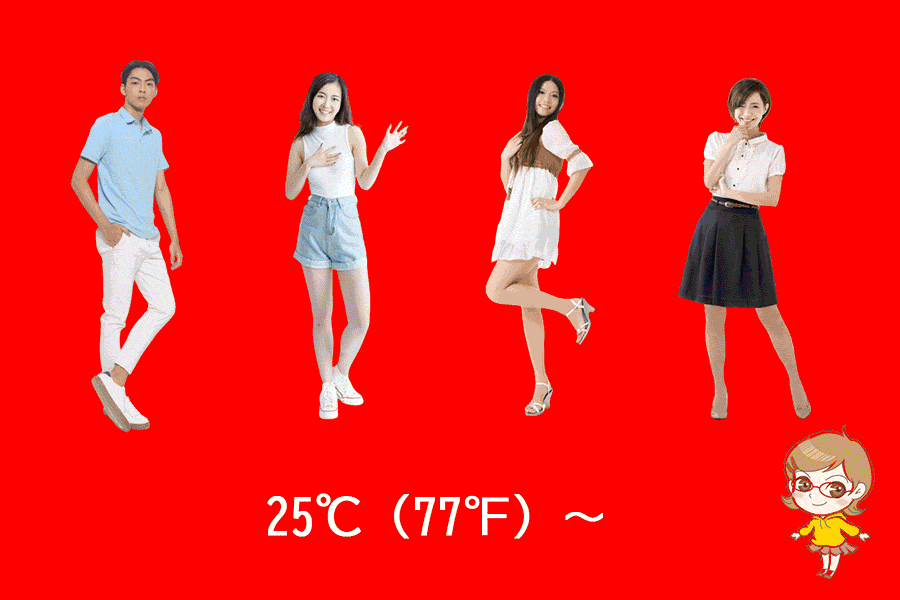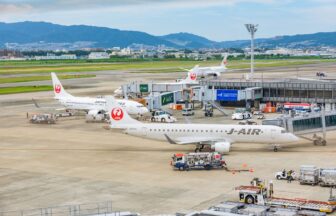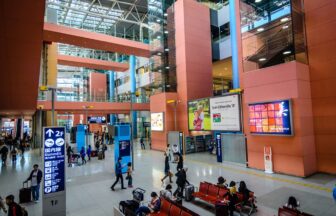3 Chome-1-1 Umeda, Kita Ward, Osaka MAP
↓ Click to jump to the relevant section.
| Current Weather | Annual Weather | Tourist Attractions |
| Baggage Deposit | Hotels |
Current weather and clothing

The weather information shown here is the information closest to the station in question. Please note that there may be slight differences.
Yearly temperature changes and recommended clothing
Clothing recommendations for each temperature range
When traveling in Japan with the following average temperatures, the recommended clothing is as follows:
Monthly changes in temperature, precipitation, and snowfall (1991~2020 average, Japan Meteorological Agency survey)
| Jan. | Feb. | Mar. | Apr. | May | Jun. | Jul. | Aug. | Sep. | Oct. | Nov. | Dec. | |
| temperature(°C) | 6.2 | 6.6 | 9.9 | 15.2 | 20.1 | 23.6 | 27.7 | 29 | 25.2 | 19.5 | 13.8 | 8.7 |
| precipitation(mm) | 47 | 60.5 | 103.1 | 101.9 | 136.5 | 185.1 | 174.4 | 113 | 152.8 | 136 | 72.5 | 55.5 |
| snowfall(cm) | 2 | 4 | 0 | — | — | — | — | — | — | — | 0 | 0 |
Winter
December
In December, the winter season begins in Osaka Station, and the temperature drops significantly to an average of 8.7°C. It is a cold and dry month, and sometimes it can even snow. It is essential to wear warm, layered clothing to protect oneself from the cold.
For men, it is recommended to wear warm coats, sweaters, thermals, warm trousers, and closed-toe shoes. Women can wear warm woolen coats, jackets, scarfs, gloves, trousers or jeans, and closed-toe shoes. It is recommended to bring thermals to layer up during the evenings.
January
The average temperature in January is 6.2°C, and the precipitation is around 47mm. The weather is cold and dry, and it is recommended to wear warm clothing. Men can wear thick coats or jackets, while women can wear thick sweaters or cardigans with a scarf, gloves, and a hat to keep warm. It is also advisable to wear a pair of warm boots to protect the feet from the cold.
February
In February, the temperature rises slightly to an average of 6.6°C, but the precipitation also increases to around 60.5mm. The weather is still cold, and it is advisable to continue wearing warm clothing. Men can wear a thick coat or a jacket, while women can wear a thick sweater or cardigan with a scarf, gloves, and a hat. It is recommended to wear waterproof boots to protect the feet from the rain and snow.
Spring
March
In March, the temperature rises to an average of 9.9°C, and the precipitation increases significantly to around 103.1mm. The weather is still cold, but the beginning of spring can be felt in the air. It is recommended to wear warm clothes with layers as the temperature may fluctuate throughout the day. Men can wear a jacket or a coat, while women can wear a sweater or a cardigan with a scarf, gloves, and a hat. It is advisable to wear waterproof shoes to protect the feet from the rain.
April
In April, the temperature rises to an average of 15.2°C, and the precipitation is around 101.9mm. The weather is still cool, but it is a beautiful time to visit Osaka as the cherry blossoms start to bloom. It is recommended to wear comfortable clothes that are suitable for both warm and cool weather. Men can wear a light jacket or a sweater, while women can wear a light cardigan with a scarf. It is advisable to wear comfortable shoes for walking as the city can be explored on foot.
May
In May, the average temperature in Osaka is around 20.1°C, and the precipitation is approximately 136.5 mm. The weather in May is warm and mostly sunny, but it can also be rainy. It is a good idea to bring a light raincoat or umbrella with you, just in case.
For men and women, light clothing such as T-shirts, shorts, and skirts are recommended, but it may be a good idea to bring a light jacket or sweater for the cooler evenings.
Summer
June
June is one of the wettest months in Osaka with an average rainfall of 185.1 mm. The average temperature is around 23.6°C, making it a very warm and humid month. It is advisable to bring light clothing and a raincoat or umbrella with you.
For men and women, T-shirts, shorts, skirts, and light cotton dresses are recommended, as well as a light jacket for cooler evenings.
July
July is the hottest month in Osaka with an average temperature of 27.7 °C. It is also one of the wettest months with an average rainfall of 174.4 mm. The humidity in July can be very high, so it is important to stay hydrated and wear breathable clothing.
For men and women, light, breathable clothing such as T-shirts, shorts, skirts, and cotton dresses are recommended. It is also a good idea to bring a light raincoat or umbrella with you in case of sudden rain.
August
August is similar to July in terms of weather, with an average temperature of 29°C and an average rainfall of 113 mm. The humidity remains high, so it is essential to wear breathable clothing and stay hydrated.
For men and women, light and breathable clothing such as T-shirts, shorts, skirts, and cotton dresses are recommended. It is also advisable to bring a light raincoat or umbrella with you.
Autumn
September
In September, the weather starts to cool down, with an average temperature of 25.2°C and an average rainfall of 152.8 mm. The weather is still warm and humid, but the humidity starts to decrease.
For men and women, light clothing such as T-shirts, shorts, skirts, and cotton dresses are recommended, but it is a good idea to bring a light jacket or sweater for the cooler evenings.
October
In October, the autumn season is in full swing, and the weather begins to get cooler. The average temperature in Osaka Station during this month is 19.5°C. During the day, it is usually sunny, and the temperature is pleasant, but at night the temperature can drop significantly, so it is essential to bring layers of clothing.
For men, it is recommended to wear lightweight, breathable long-sleeved shirts, a light jacket, and trousers or jeans. Women can opt for dresses or skirts, but it is also recommended to wear tights to stay warm. It is essential to bring a light jacket or a cardigan to layer up during the evenings.
November
In November, the temperature in Osaka Station drops significantly to an average of 13.8°C. The days are shorter, and the weather is cloudy and cool, and the humidity can be high. It is essential to bring warm clothing, such as coats, jackets, sweaters, and warm pants.
For men, it is recommended to wear warm sweaters or hoodies, a coat, trousers or jeans, and closed-toe shoes. Women can wear warm jackets, woolen sweaters, turtlenecks, trousers or jeans, and closed-toe shoes. Gloves, scarves, and hats are also necessary to keep warm during the evenings.
Recommended tourist destinations
Dotombori District
Chuo-ku, Dotombori, Chuo, Osaka 542-0076 Osaka Prefecture
Dotonbori is a moat river built by Yasui Doton with his private fortune in the early Edo period. Today, the area along Dotonbori is known as the busiest shopping area in Osaka, and is lined with famous restaurants representing Osaka.
Universal Studios Japan
2-1-33 Sakurajima, Konohana-Ku, Osaka 554-0031 Osaka Prefecture
Osaka’s most popular tourist spot where visitors can experience the world of Hollywood movies. The theme park continues to evolve into a place that can be enjoyed by all generations, with the Hollywood area featuring a recreation of Hollywood streetscapes, and the recent addition of Harry Potter and Nintendo Super Mario-themed areas.
Osaka Castle
1-1 Osakajo, Chuo, Osaka 540-0002 Osaka Prefecture
The castle was built by Toyotomi Hideyoshi, a famous castle in Japan. The castle tower was destroyed by fire in 1665, and for the next 260 years there was no castle tower. The present keep was rebuilt in 1931, and the interior is used as a history museum. The area around the castle has been developed into Osaka Castle Park, where citizens can relax in a garden with beautiful cherry blossoms, a museum, and commercial facilities.
Osaka Aquarium Kaiyukan
1-1-10 Kaigandori, Minato-ku, Osaka 552-0022 Osaka Prefecture
The aquarium is one of the largest aquariums in Japan, breeding 30,000 creatures of about 620 species. The aquarium’s large tanks represent the natural environment of various regions around the Pacific Rim. Whale sharks swimming gracefully in the large tank are the aquarium’s most popular animals.
Shinsaibashi-suji Shopping Street
Shinsaibashi-suji, Chuo, Osaka 542-0085 Osaka Prefecture
The Shinsaibashisuji Shopping -Arcade stretches 580 meters from the south side of Nagahori Dori to Soemoncho Dori from north to south. It is lined with about 180 stores, including two major department stores, Daimaru Shinsaibashi Store, as well as clothing stores and restaurants, and attracts about 60,000 shoppers on weekdays and 120,000 shoppers on Sundays and holidays.
Sumiyoshi Taisha Shrine
2-9-89 Sumiyoshi, Sumiyoshi-ku, Osaka 558-0045 Osaka Prefecture
Widely worshipped as the god of navigation since ancient times, it is one of Osaka’s representative shrines. More than 2 million people visit the shrine on New Year’s Day for Hatsumode (New Year’s visit). The main shrine, built in a unique architectural style known as Sumiyoshi-zukuri, is designated as a national treasure.
Kuromon Market
2-4-1, Nippombashi, Chuo, Osaka 542-0073 Osaka Prefecture
This market has been in existence since the late Edo period (1603-1867) and has both wholesale and retail functions, serving the stomachs of the Naniwa people. About 150 stores selling fresh fish, fruits and vegetables, food and beverages, clothing, etc. line the 580-meter street south of Sennichimae, attracting about 18,000 visitors on weekdays and 150,000 at the end of the year.
National Bunraku Theater
1-12-10, Nippombashi, Chuo, Osaka 542-0073 Osaka Prefecture
This theater is where you can watch Bunraku, a uniquely Japanese traditional performing art that has been registered as a UNESCO Intangible Cultural Heritage. Bunraku is a form of drama in which a tayu, or tayu, tells a story and the characters’ lines to the accompaniment of shamisen music, and the puppets move in time with the music. In the exhibition room on the first floor of the theater, valuable materials related to Bunraku and special exhibitions held irregularly are available for everyone to enjoy (free admission).
Shinsekai
1 Ebisuhigashi, Naniwaku, Osaka 556-0002 Osaka Prefecture
Downtown Osaka in the southern part of the city is famous for Tsutenkaku Tower, Janjan Yokocho, and large puffer fish lantern signs. The Tsutenkaku Observation Deck is crowded with tourists from far and wide, and at the underground Tsutenkaku Theater directly below, singers from various regions sing enka (traditional Japanese ballads) every Monday, and at the Tsutenkaku Theater Tengeki, manzai and Kamigata Rakugo entertain the audience every Saturday and Sunday.
Shitennoji
1-11-18 Shitennoji, Tennoji-Ku, Osaka 543-0051 Osaka Prefecture
Founded in 593 by Prince Shotoku, this was the first official temple of Buddhism in Japan. The temple is full of attractions such as the layout of the temple buildings, which have been handed down from the time of its foundation, and the halls associated with the ancestors of various religious sects that transcend the boundaries of sectarianism.
Where to leave your luggage
Since Umeda-Osaka Station is the largest terminal station in western Japan, there are more than 3,000 coin lockers in the area.
For this reason, there are three “Coin Locker Search Machines” located in Osaka Station that show the locations and availability of coin lockers.It is also recommended to use the “Railway and Tourist Information Center” located right in front of the Osaka Station Central Exit ticket gate to gather information.
In addition to coin lockers, there is also a “Crosta Osaka” baggage storage facility. On the first floor of Osaka Station, go through the central ticket gate toward the left and turn right at the corner where Nippon Travel Agency is located. Go straight ahead and you will find Crosta Osaka on the right side. Hours of operation are from 8:00 to 20:00. For an additional fee, we also offer luggage transportation service to partner hotels in the neighborhood.
Recommended hotels and inns
Imperial Hotel Osaka
1-8-50 Temmabashi, Kita-Ku, Osaka 530-0042 Osaka Prefecture
1.3mi/2.1km from Osaka Station/Umeda Station
Hotel class: 5
Hotel style: River View , Park View
Check Rates & Availability:
>> See on Tripadvisor
>> See on Trip.com
>> See on Expedia
RIHGA Royal Hotel Osaka
5-3-68 Nakanoshima, Kita-ku, Osaka 530-0005 Osaka Prefecture
20-minutes walk from Osaka Station/Umeda Station
Hotel class: 4.5
Hotel style: Classic , Quiet
Check Rates & Availability:
>> See on Tripadvisor
>> See on Trip.com
>> See on Expedia
Hotel Granvia Osaka
3-1-1 Umeda Kita-ku, Osaka 530-0001 Osaka Prefecture
1-minute walk from Osaka Station/Umeda Station
Hotel class: 4
Hotel style: Centrally Located , Modern
Check Rates & Availability:
>> See on Tripadvisor
>> See on Trip.com
>> See on Expedia
Hotel Hankyu Respire Osaka
1-1 Ofukacho, Kita-Ku, Osaka 530-0011 Osaka Prefecture
5-minutes walk from Osaka Station/Umeda Station
Hotel class: 4
Hotel style: Centrally Located , Modern
Check Rates & Availability:
>> See on Tripadvisor
>> See on Trip.com
>> See on Expedia
Mitsui Garden Hotel Osaka Premier
3-4-15 Nakanoshima, Kita-Ku, Osaka 530-0005 Osaka Prefecture
14-minutes walk from Osaka Station/Umeda Station
Hotel class: 4
Hotel style: Modern , River View
Check Rates & Availability:
>> See on Tripadvisor
>> See on Trip.com
>> See on Expedia
Hotel Nikko Osaka
1-3-3 Nishishinsaibashi, Chuo, Osaka 542-0086 Osaka Prefecture
1.9mi/3.1km from Osaka Station/Umeda Station
Hotel class: 4
Hotel style: Centrally Located , Modern
Check Rates & Availability:
>> See on Tripadvisor
>> See on Trip.com
>> See on Expedia
Hotel Vischio Osaka by Granvia
2-4-10 Shibata, Kita-ku, Osaka 530-0012 Osaka Prefecture
7-minutes walk from Osaka Station/Umeda Station
Hotel class: 3.5
Hotel style: Business , Family
Check Rates & Availability:
>> See on Tripadvisor
>> See on Trip.com
>> See on Expedia
Hotel New Hankyu Osaka
1-1-35 Shibata, Kita-Ku, Osaka 530-8310 Osaka Prefecture
4-minutes walk from Osaka Station/Umeda Station
Hotel class: 3
Hotel style: Centrally Located , Business
Check Rates & Availability:
>> See on Tripadvisor
>> See on Trip.com
>> See on Expedia
Hotel Brighton City Osaka Kitahama
1-1 Fushimimachi, Chuo, Osaka 541-0044 Osaka Prefecture
1.1mi/1.8km from Osaka Station/Umeda Station
Hotel class: 3
Hotel style: Modern , Mid-range
Check Rates & Availability:
>> See on Tripadvisor
>> See on Trip.com
>> See on Expedia
The Lively Honmachi Osaka
1-1-35 Shibata, Kita-Ku, Osaka 530-8310 Osaka Prefecture
1.5mi/2.4km from Osaka Station/Umeda Station
Hotel class: 3
Hotel style: Business
Check Rates & Availability:
>> See on Tripadvisor
>> See on Trip.com
>> See on Expedia
We support your itinerary planning!
Click the button to get an overview of hotel information and popular tourist routes from all over Japan featured on our site. We’ve included comprehensive details to aid in planning your trip, so please make use of it.
Comprehensive checklist before traveling to Japan

Book flights
Compare and purchase flight tickets
When planning your trip to Japan, it's advisable to start by researching flights several months in advance. Airlines often release promotional fares, especially during off-peak seasons. Use comparison sites like Skyscanner or KAYAK to get a sense of the price range. Be flexible with your travel dates if possible; flying mid-week might be cheaper than on weekends.
>> Visit Skyscanner's official website
>> Visit KAYAK's official website
Order Japan Rail Passes for each family member
Purchase your Japan Rail Pass before departure
The Japan Rail (JR) Pass offers unlimited travel on JR trains, making it a cost-effective option for tourists. However, it's only available to foreign tourists and must be purchased *before* you arrive in Japan. Determine the areas you plan to visit; if you're traveling extensively, a nationwide pass is beneficial, but if you're only exploring a specific region, consider regional JR passes. Children under 12 get a discounted pass, so ensure you order the correct type for each family member.
>>Visit Japan Rail Pass's website
Plan your attire for Japan
Check the weather at your destination on this site
Japanese weather varies significantly by season. In summer, it's hot and humid, so breathable clothes are essential. Winters, especially in the north, can be cold, requiring warm attire. If visiting during the rainy season (June to early July), pack a good umbrella and waterproof shoes. While Japan is generally casual, certain places like temples, shrines, or upscale restaurants may require modest and neat dressing.
Reserve a pocket Wi-Fi or SIM card

SIM card or pocket Wi-Fi is required
Beyond clothes, consider packing essentials like a universal power adapter (Japan uses Type A and B sockets), portable Wi-Fi or SIM card for internet access, and any necessary medications (with a copy of the prescription).
Which is better: a SIM card or pocket Wi-Fi?
When traveling in Japan, one essential to consider is securing internet access, especially given that many locations still don't offer free Wi-Fi. To ensure you can use your smartphone throughout your trip, you'll typically have three options: (1) a SIM card, (2) pocket Wi-Fi, or (3) the roaming service provided by your mobile company. Roaming services can be quite expensive, so we often recommend using a SIM card or pocket Wi-Fi. While SIM cards tend to be more affordable than pocket Wi-Fi, they can be trickier to set up. Pocket Wi-Fi, on the other hand, can be shared among several users, making it a favorable choice for families or groups.
▼SIM card
Advantages:
Relatively affordable.
Disadvantages:
Can be time-consuming to set up initially.
May have strict data limits.
▼Pocket Wi-Fi
Advantages:
Offers substantial data allowances.
A single device can be shared among multiple users.
Easily usable with PCs as well.
Disadvantages:
Typically more expensive.
Japan's representative services

Sakura Mobile's website
▼SIM card
>>Visit Sakura Mobile's official website
>>Visit mobal's official website
▼pocket Wi-Fi
>>Visit Sakura Mobile's official website
>>Visit NINJA WiFi's official website
>>Visit Wi-Fi RENTAL Store's official website
Book local tours as needed
Pre-book your tour and have a great trip!
Local tours offer deep insights into Japan's culture and heritage. Websites like Viator or GetYourGuide offer a variety of tours, from traditional tea ceremonies to modern pop culture tours in Akihabara. Consider unique experiences like staying with monks on Mt. Koya or taking a cooking class to learn authentic Japanese dishes.
>>Visit Viator's official website
>>Visit GetYourGuide's official website
Purchase advance tickets for popular attractions
Make a reservation to avoid crowds
Attractions like Tokyo Disneyland, Universal Studios Japan, or the Studio Ghibli Museum often have long ticket queues. Buy tickets online in advance to save time. Some attractions also have timed entry, so check the specific time slots available and plan accordingly.
▼Tokyo Disney Resort
>>Visit Tokyo Disney Resort official website
>>Visit Viator's Tokyo Disneyland page
>>Visit Viator's Tokyo DisneySea page
>>Visit GetYourGuide's Tokyo Disneyland page
>>Visit GetYourGuide's Tokyo DisneySea page
▼Universal Studios Japan
>>Visit USJ official website
>>Visit Viator's USJ page
>>Visit GetYourGuide's USJ page
Buy travel insurance

insurance concept, health, life and travel insurance
It is important to be prepared for emergencies
While Japan is a safe country, travel insurance is crucial for unforeseen events like health emergencies, travel disruptions, or lost baggage. Ensure your policy covers medical expenses in Japan, as healthcare, though excellent, can be expensive.
Here we introduce online travel insurance services that are popular worldwide.
World Nomads: An online travel insurance service widely endorsed by travelers worldwide. They offer plans that cover adventurous activities and high-risk sports.
>>Visit World Nomads' official website
AIG Travel Guard: An insurance service available to travelers all over the world. They offer a wide range of options, including cancellation protection and emergency medical insurance.
>>Visit AIG Travel Guard's official website
Share your itinerary with emergency contacts
Organize your reservation information
Keep a digital and printed copy of your detailed itinerary, including hotel addresses, train schedules, and booked tours. Share this with a trusted family member or friend not traveling with you.

















